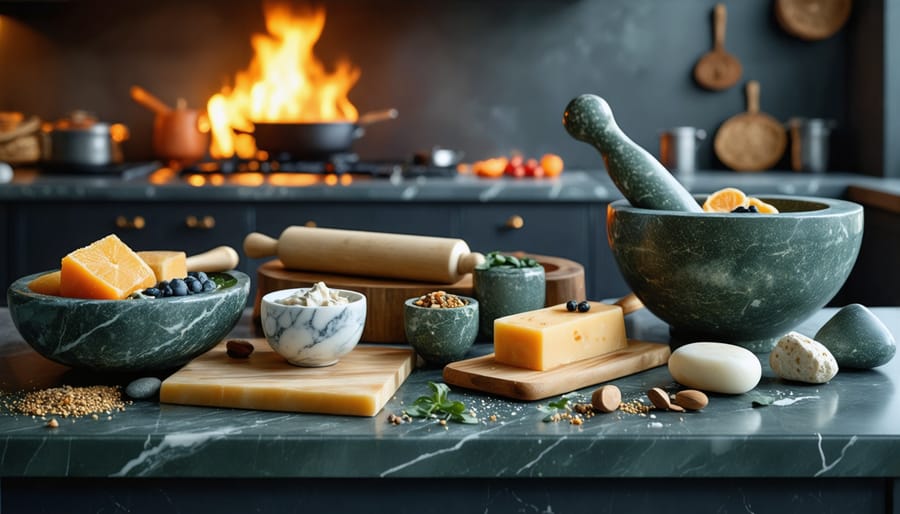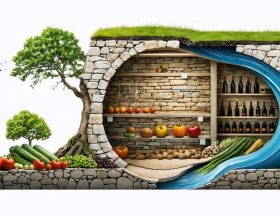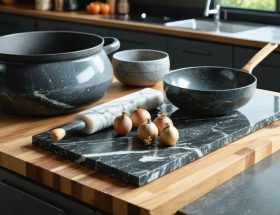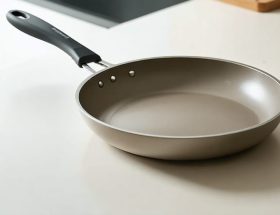Transform your kitchen into a culinary laboratory with ancient-meets-modern cooking tools that professional chefs quietly rely on. From baking stones that create restaurant-quality crusts to volcanic salt plates that infuse dishes with subtle minerality, these unconventional implements bridge centuries of cooking wisdom with contemporary innovation.
Beyond the familiar spatulas and mixing bowls lies a world of specialized tools that can elevate ordinary cooking into extraordinary culinary experiences. Himalayan salt blocks double as serving platters while slowly seasoning food, while Japanese donabe clay pots create perfectly steamed rice through time-tested heat distribution techniques. These tools aren’t just implements – they’re gateways to cooking methods that have stood the test of time while embracing modern kitchen demands.
The most fascinating cooking tools often draw from ancient traditions: heated river stones for soup-making, granite mortar and pestles that extract flavors conventional blenders can’t touch, and volcanic glass graters that transform wasabi root into paste with unparalleled precision. Each offers a unique combination of functionality and time-honored craftsmanship that mass-produced alternatives simply can’t match.
The Science Behind Stone-Infused Cookware
Natural Heat Distribution Properties
Different types of stone materials exhibit unique thermal properties that make them valuable for cooking applications. The principles behind heat distribution in stone cookware explain why these tools have been treasured for centuries. Granite, for instance, heats slowly but maintains consistent temperatures, making it ideal for prolonged cooking sessions. Soapstone offers superior heat retention, gradually releasing stored energy over time, which helps maintain food temperature long after removal from heat sources.
Marble’s thermal conductivity falls between granite and soapstone, providing balanced heat distribution that’s particularly beneficial for pastry work. Its cooler surface temperature makes it perfect for chocolate tempering and dough preparation. Basalt, with its volcanic origins, demonstrates excellent heat stability and resistance to thermal shock, making it suitable for high-temperature cooking applications.
These natural materials eliminate hot spots common in metal cookware, ensuring even cooking results and reducing the risk of burned food. Their thermal mass also helps regulate cooking temperatures, making them forgiving tools for both novice and experienced cooks.
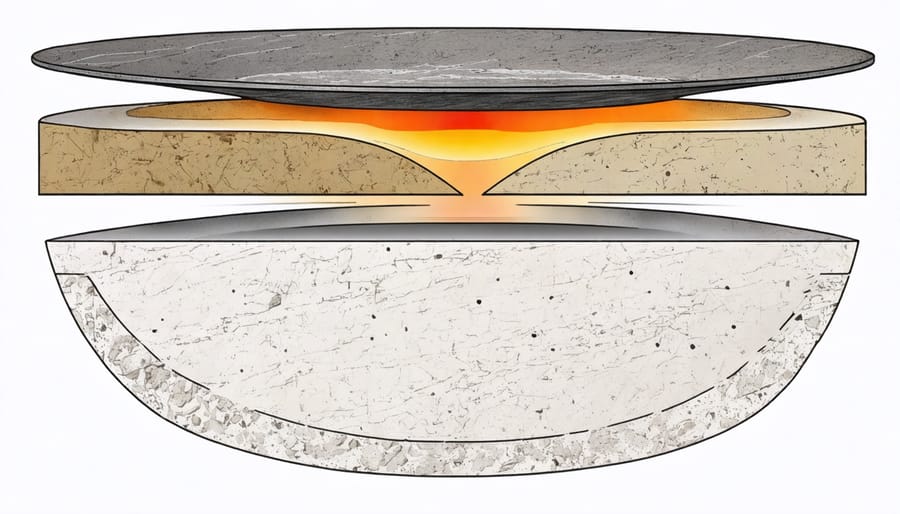
Non-Toxic Cooking Surfaces
Natural stone cooking surfaces offer a safer, more sustainable alternative to synthetic non-stick cookware. Materials like granite, soapstone, and marble have been used for centuries in food preparation, providing naturally non-toxic cooking surfaces that don’t leach harmful chemicals into food. Unlike synthetic coatings that can deteriorate over time, these stone surfaces maintain their integrity even at high temperatures.
Granite, particularly, excels as a cooking surface due to its exceptional heat retention and distribution properties. Its dense crystalline structure creates a natural non-stick surface that requires minimal oil for cooking. Soapstone, another excellent option, offers superior heat retention and a naturally antimicrobial surface that inhibits bacterial growth.
Traditional cooking stones like Japanese shichirin grills and Indian sil batta grinding stones demonstrate how these materials have stood the test of time. Modern manufacturers are now incorporating these time-tested materials into contemporary kitchen tools, creating innovative hybrid products that combine the benefits of natural stone with modern design elements.
When properly maintained, these stone surfaces can last generations, making them both environmentally friendly and cost-effective in the long run.
Revolutionary Stone Cooking Tools
Granite Mortar and Pestles
Granite mortar and pestles represent a perfect marriage of ancient wisdom and contemporary design innovation. These heavy-duty kitchen tools, carved from solid granite, offer superior grinding capabilities compared to their ceramic or wooden counterparts. The naturally rough texture of granite creates an ideal grinding surface that breaks down spices, herbs, and other ingredients more effectively.
Modern granite mortars feature thoughtful design improvements that address common user complaints about traditional versions. Many now incorporate a wider, more stable base to prevent tipping, while the interior bowl often has optimized angles that make it easier to gather ingredients toward the center. The pestles are ergonomically shaped for comfortable grinding, with some designs featuring dual ends for different grinding intensities.
The weight of granite provides natural stability during use, while its density helps maintain consistent temperatures – particularly important when making delicate emulsions like aioli or pesto. The non-porous nature of properly finished granite means it won’t absorb flavors or odors, making it suitable for both sweet and savory preparations.
Maintenance is straightforward – simply wash with warm water and mild soap, then dry thoroughly. Unlike wooden alternatives, granite mortars don’t require special seasoning or conditioning. With proper care, these tools can last for generations, developing a natural patina that adds character without compromising functionality.
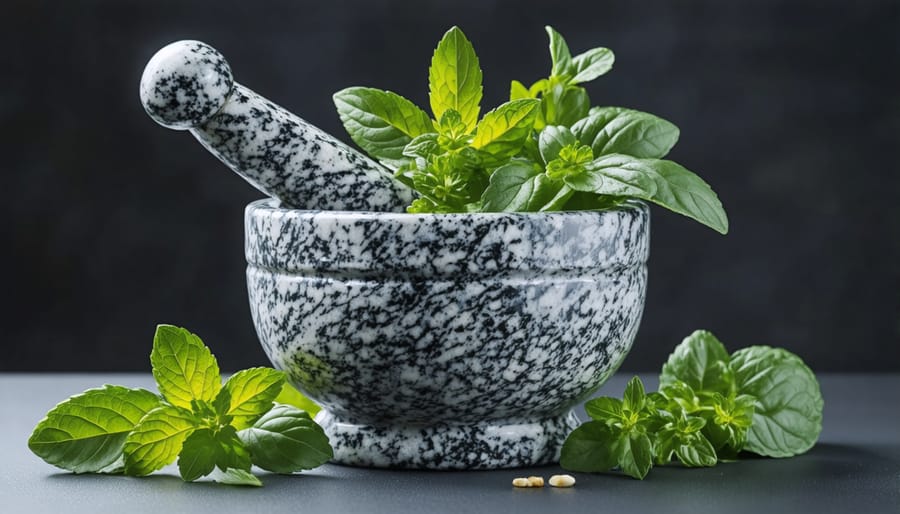
Marble Rolling Pins
Marble rolling pins stand out as one of the most practical yet underappreciated tools in pastry making, offering unique benefits that stainless steel or wooden alternatives can’t match. The natural properties of marble make it exceptionally temperature-stable, maintaining a consistently cool surface that’s crucial for working with butter-based doughs.
The stone’s natural coolness prevents butter from melting during the rolling process, which is essential for achieving flaky, layered pastries like croissants and pie crusts. Unlike wooden rolling pins that can warm up quickly from handling, marble stays cool even during extended use, eliminating the need for frequent trips to the refrigerator to chill your dough.
These rolling pins are particularly hefty, and this additional weight works to your advantage. The natural weight of marble helps flatten dough with minimal effort, requiring less pressure from the baker and resulting in more even, consistent results. The smooth, polished surface also provides excellent non-stick properties, especially when lightly dusted with flour.
While marble rolling pins require a bit more care in handling due to their weight and potential for chipping if dropped, their durability makes them a lifetime investment for serious bakers. They’re also remarkably easy to clean – their non-porous surface prevents dough from sticking and bacteria from harboring, making them both practical and hygienic.
Soapstone Cooking Stones
Soapstone cooking stones represent one of the most versatile and long-lasting cooking platforms available in modern kitchens. These dense, natural stones possess remarkable heat retention properties, maintaining consistent temperatures for extended periods. Unlike metal or ceramic surfaces, soapstone gradually releases heat, making it ideal for both cooking and serving dishes.
The non-porous nature of soapstone means it won’t absorb flavors, odors, or bacteria, making it exceptionally hygienic for food preparation. Chefs particularly value these stones for searing meats, as they can be heated to high temperatures and create an excellent crust while keeping the interior perfectly cooked.
These cooking stones are equally impressive for cold service. When chilled, they maintain cold temperatures longer than traditional serving platters, making them perfect for sushi, cheese boards, or cold appetizers. Their natural gray color, often featuring subtle veining, adds an elegant touch to table presentations.
Maintenance is straightforward – simply wash with warm water and mild soap, then season occasionally with mineral oil to maintain the stone’s natural luster. While initially more expensive than conventional cooking surfaces, soapstone’s durability and versatility make it a worthwhile investment for serious home cooks and professional chefs alike. Many stones come with wooden serving trays, combining functionality with safe handling.
Granite Cooking Slabs
Granite cooking slabs represent a sophisticated evolution in cooking with stone surfaces, offering home chefs a versatile platform that combines ancient wisdom with modern functionality. These substantial stone pieces, typically measuring 16 to 24 inches across and about 1.5 inches thick, provide exceptional heat retention and distribution properties that transform ordinary cooking into a precise culinary art.
The dense crystalline structure of granite makes these slabs ideal for multiple cooking applications. When heated, they maintain consistent temperatures far longer than conventional cookware, making them perfect for searing meats, baking artisanal breads, or keeping dishes warm during service. Their naturally cool surface temperature when unchilled also makes them excellent for pastry preparation and chocolate work.
What sets granite cooking slabs apart is their adaptability to temperature extremes. They can withstand both high-heat oven applications and freezer storage, allowing cooks to temperature-shock ingredients or maintain precise cooling conditions for delicate preparations. The non-porous nature of properly sealed granite ensures food safety while preventing flavor transfer between uses.
These slabs often feature a polished cooking surface with slightly textured edges for secure handling. Many contemporary designs include carved channels for collecting juices or integrated serving platforms, making them as functional for presentation as they are for cooking.
Care and Maintenance
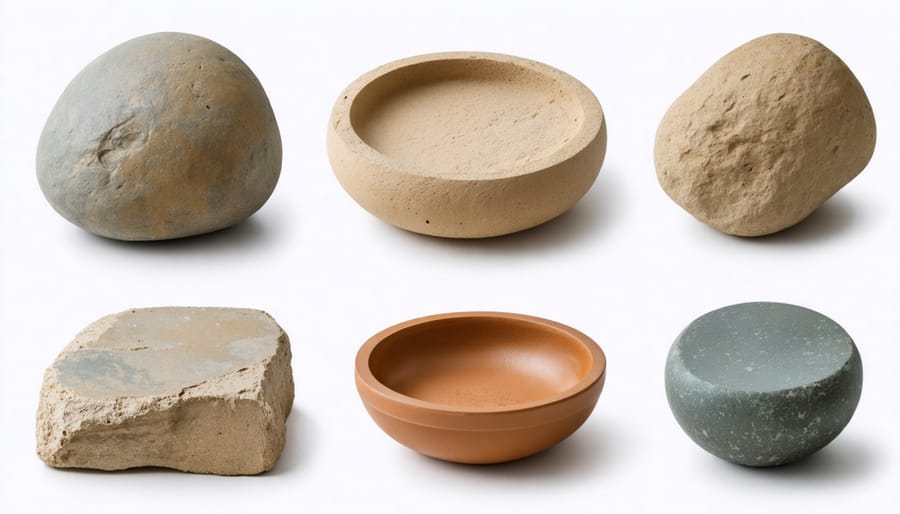
Cleaning Techniques
Proper stone cooking surface maintenance is crucial for preserving the longevity and performance of your unique culinary tools. For granite and marble implements, use warm water and mild dish soap, avoiding harsh chemicals that can damage the stone’s surface. After cleaning, thoroughly dry the tools to prevent water spots and mineral buildup.
Volcanic stone tools, like molcajetes, require special attention. Before first use, season them by grinding uncooked rice until the powder comes out clean. For regular cleaning, use a stiff brush with warm water, never soap, as the porous surface can absorb cleaning agents. Salt plates should be gently scrubbed with a damp cloth, as they will dissolve if submerged in water.
For pizza stones and baking slabs, allow them to cool completely before cleaning. Remove debris with a scraper, then wipe with a damp cloth. Never soak these tools or use soap, as this can affect their natural seasoning and non-stick properties. Store all stone tools in a dry place to prevent moisture damage and potential cracking.
Storage Solutions
Proper storage of stone cooking tools is essential for maintaining their quality and extending their lifespan. Store stone mortars, pestles, and cooking slabs in a dry, temperature-controlled environment to prevent moisture absorption and potential cracking. Avoid stacking heavy items on top of stone tools, as this can lead to unnecessary stress and potential damage.
For larger stone implements like cooking slabs or pizza stones, consider using padded storage bags or dedicated shelf space where they won’t be jostled or knocked against other kitchen items. Smaller tools like stone pestles can be stored upright in sturdy utensil holders, while mortars should be placed on stable surfaces away from edges.
Before storing, ensure all stone tools are completely dry to prevent mold growth or mineral deposits. If possible, store items away from direct sunlight, which can cause uneven heating and potential damage over time. For particularly valuable or delicate stone pieces, consider wrapping them in soft cloth or installing protective padding in storage areas.
Avoid storing stone tools in areas with high humidity, such as under the sink or near dishwashers, as excessive moisture can compromise their integrity.
Making the Investment
When considering unusual cooking tools, particularly those incorporating natural stone elements, it’s essential to view them as long-term investments rather than simple kitchen gadgets. While the initial cost of items like granite mortar and pestles, salt blocks, or marble rolling pins may be higher than their conventional counterparts, their durability and versatility often justify the expense.
High-quality stone cooking tools typically range from $30 for basic items to several hundred dollars for larger, more specialized pieces. However, these tools often last for generations when properly maintained, making their cost-per-use remarkably low. A well-crafted marble pastry board, for instance, might cost $100-150 but can serve as both a functional workspace and an elegant serving platform for decades.
Consider starting with one or two essential stone pieces that align with your cooking style. A granite mortar and pestle set is an excellent entry point, offering versatility for spice grinding, sauce making, and herb crushing. As you become comfortable with stone tools, you can gradually expand your collection.
When evaluating purchases, focus on reputable manufacturers who source high-quality stone and maintain strict quality control standards. Look for tools with proper certification and food-grade materials. While artisanal pieces may carry premium prices, they often offer superior craftsmanship and unique characteristics that mass-produced alternatives can’t match.
Stone-infused cooking tools represent a fascinating bridge between ancient culinary traditions and modern kitchen innovation. These unique implements offer home cooks and professional chefs alike a blend of durability, natural heat retention, and enhanced flavor development that conventional cookware often struggles to match. From granite mortar and pestles to soapstone cooking slabs, these tools have proven their worth in contemporary kitchens while maintaining their timeless appeal.
The benefits of stone cooking implements extend beyond their practical applications. Their natural antimicrobial properties, minimal environmental impact, and ability to last for generations make them an sustainable choice for environmentally conscious consumers. Moreover, their aesthetic appeal adds an element of rustic elegance to any kitchen setting, transforming ordinary cooking tools into conversation pieces that celebrate the marriage of form and function.
As our understanding of traditional cooking methods continues to evolve, stone-infused tools are experiencing a well-deserved renaissance in modern kitchens. Their versatility in handling everything from grinding spices to slow-cooking delicate dishes makes them indispensable for cooks seeking to expand their culinary horizons. While they may require specific care and maintenance, the superior cooking results and longevity of stone tools make them a worthwhile investment for anyone serious about their culinary craft. As we look to the future of kitchen innovation, these time-tested tools remind us that sometimes the most effective solutions have been with us all along.

